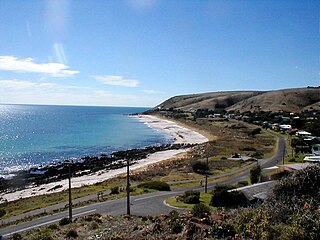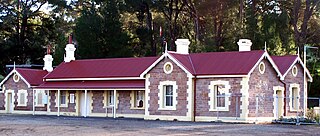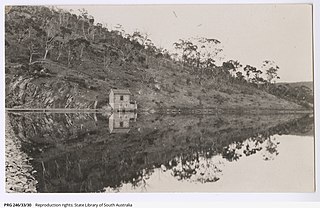
The Southern Argus is a newspaper first published from March 1866 in Port Elliot, South Australia, and then in Strathalbyn from 1868 to the present. [1] [2] It is published on Thursdays.

The Southern Argus is a newspaper first published from March 1866 in Port Elliot, South Australia, and then in Strathalbyn from 1868 to the present. [1] [2] It is published on Thursdays.
The Southern Argus (as distinct from the Northern Argus published in Clare) is one of the state's oldest country newspapers, privately owned by the Elliott and Jones families for 140 years. It was founded by Ebenezer Ward (1837–1917) in Port Elliot as a weekly newspaper, the first issue appearing on Saturday 17 March 1866. While primarily called the Southern Argus, for the first decade it was also subtitled; [3] "And Strathalbyn, Wellington, Milang, Langhorne's Creek, Woodchester, Mount Barker, Echunga, Macclesfield, Bull's Creek, Clarendon, Noarlunga, Willunga, Aldinga, Sellick's Hill, Myponga, Normanville, Yankalilla, Rapid Bay, Cape Jervis, Inman Valley, Bald Hills, Hindmarsh Valley, Encounter Bay, Victor Harbor, Port Elliot, Middleton, Currency Creek and Goolwa,.and River Murray Advertiser."
Ward expected that the new southern port of Port Elliot was to become an enterprising outlet for the River Murray trade. Using the original Observer printing press, Ward set up the newspaper in the small coastal town; its first office was previously J. Barton's shop. In mid-April 1868, following financial difficulties and ownership changes, the production of the newspaper moved to William Colman's shop in Strathalbyn, [4] then on 5 December 1868, to their new building adjacent to the Strathalbyn Post Office. It was purchased in 1871 by William Fisher and Joseph Elliott (c. 1833 – 21 May 1883), the latter whose brother James Elliott (c. 1836 – 22 April 1883) was the first owner of The Kapunda Herald . [5] Elliott bought his partner out shortly after. [6]
Joseph W. Elliott (1853–1939), only son of Joseph Elliott, [7] was educated by W. S. Moore, later at Adelaide Educational Institution. When his father died, he quit university to take over the newspaper. He was elected mayor of Strathalbyn in 1898. [8] In 1912 he founded the Victor Harbor Times, whose first editor was his son Cecil Cave Elliott (1889– ). [9]
The long title of the newspaper persisted until 5 July 1877 when it was shortened to the Southern Argus and River Murray Advertiser. On 4 January 1893, it lengthened again to TheSouthern Argus Strathalbyn, Goolwa, and River Murray Advertiser, later variously re-adding Victor Harbor, Milang, Meningie. On 14 August 1940, the subtitle was finally removed.
The Southern Argus published serials and poems by South Australian writers. The first serial was Middle Life: a tale by James Dunlop, in 1870. [10] [11]
The publication's early coverage included the towns of: Strathalbyn, Wellington, Milang, Langhorne's Creek, Woodchester, Mount Barker, Echunga, Macclesfield, Bull's Creek, Clarendon, Noarlunga, Willunga, Aldinga, Sellick's Hill, Myponga, Normanville, Yankalilla, Rapid Bay, Cape Jervis, Inman Valley, Bald Hills, Hindmarsh Valley, Encounter Bay, Victor Harbor, Port Elliot, Middleton, Currency Creek, and Goolwa.
This newspaper title has been preserved on microfilm by the State Library of South Australia. [12] It has been digitised from the microfilm for the Australian Newspapers Digitisation Project of the National Library of Australia. [13]
The Division of Mayo is an Australian electoral division located to the east and south of Adelaide, South Australia. Created in the state redistribution of 3 September 1984, the division is named after Helen Mayo, a social activist and the first woman elected to an Australian University Council. The 9,315 km2 rural seat covers an area from the Barossa Valley in the north to Cape Jervis in the south. Taking in the Adelaide Hills, Fleurieu Peninsula and Kangaroo Island regions, its largest population centre is Mount Barker. Its other population centres are Aldgate, Bridgewater, Littlehampton, McLaren Vale, Nairne, Stirling, Strathalbyn and Victor Harbor, and its smaller localities include American River, Ashbourne, Balhannah, Brukunga, Carrickalinga, Charleston, Cherry Gardens, Clarendon, Crafers, Cudlee Creek, Currency Creek, Delamere, Echunga, Forreston, Goolwa, Gumeracha, Hahndorf, Houghton, Inglewood, Kersbrook, Kingscote, Langhorne Creek, Lobethal, Macclesfield, McLaren Flat, Meadows, Middleton, Milang, Mount Compass, Mount Pleasant, Mount Torrens, Mylor, Myponga, Normanville, Norton Summit, Oakbank, Penneshaw, Piccadilly, Port Elliot, Second Valley, Springton, Summertown, Uraidla, Willunga, Woodchester, Woodside, Yankalilla, and parts of Birdwood, Old Noarlunga and Upper Sturt.

Alexandrina Council is a local government area in the Fleurieu and Kangaroo Island region of South Australia. The Alexandrina Council was formed on 1 July 1997 by the amalgamation of the District Council of Port Elliot and Goolwa, the District Council of Strathalbyn and a portion of the District Council of Willunga. The council is divided into five wards: Nangkita Kuitpo, Angas Bremer, Port Elliot Middleton, Strathalbyn and Goolwa Hindmarsh Island.

Harry Hewitt, sometimes spelled "Hewit", "Ewart" or "Hewett", was an Indigenous Australian cricketer and Australian rules footballer. In 1889, Hewitt played for the Medindie Football Club, and so is believed to be the first Indigenous Australian to play in the South Australian Football Association (SAFA), known today as the South Australian National Football League (SANFL).

Heysen is a single-member electoral district for the South Australian House of Assembly. It is named after Sir Hans Heysen, a prominent South Australian landscape artist. It is a 1,074 km2 electoral district that takes in some of the outer southern suburbs of Adelaide before fanning south-east to include most of the Adelaide Hills, as well as farming areas some distance from the capital. It includes the localities of Aldgate, Ashbourne, Belvidere, Biggs Flat, Blackfellows Creek, Blewitt Springs, Bradbury, Bridgewater, Bugle Ranges, Bull Creek, Chapel Hill, Clarendon, Crafers, Dingabledinga, Dorset Vale, Echunga, Flaxley, Gemmells, Green Hills Range, Heathfield, Highland Valley, Hope Forest, Ironbank, Jupiter Creek, Kangarilla, Kuitpo, Kuitpo Colony, Kyeema, Longwood, Macclesfield, McHarg Creek, Meadows, Montarra, Mount Magnificent, Mylor, Paris Creek, Prospect Hill, Red Creek, Salem, Sandergrove, Scott Creek, Stirling, Strathalbyn, The Range, Willunga Hill, Willyaroo, Wistow, Woodchester, Yundi; as well as parts of Bletchley, Hartley, Onkaparinga Hills, Upper Sturt. Although geographically it is a hybrid urban-rural seat, it is counted as a metropolitan seat.

The District Council of Yankalilla is a local government area centred on the town of Yankalilla on the Fleurieu Peninsula in South Australia.

Carrickalinga is a small coastal town in South Australia about 60 kilometres (37 mi) south of Adelaide on the Fleurieu Peninsula overlooking Gulf St Vincent. The town has no shops, with the nearest being in Normanville, one kilometre away. Haycock Point separates two beaches, sometimes referred to as North Carrickalinga and South Carrickalinga beaches, both on Yankalilla Bay. Carrickalinga Creek discharges into the sea south of the town.

The Victor Harbor railway line is a 1600 mm broad gauge line in South Australia. It originally branched from the Adelaide to Melbourne line at Mount Barker Junction then ran 80.6 kilometres south to Victor Harbor. When the mainline was converted to 1435 mm standard gauge and the junction was closed, the northern end of the Victor Harbor line was curtailed at Mount Barker, 3 kilometres from the junction.

The South Australian Railways 350 class comprised two diesel-electric locomotives built by the railway's Islington Railway Workshops, entering service in June 1949. They were the first diesel-electric locomotives built in Australia and the first to be operated by the South Australian Railways.

Albert Henry Landseer was a businessman and politician in the early days of the colony of South Australia. He was a pioneer of the River Murray steamboat trade.
The Willunga Football Club is an Australian rules football club first formed on 29 May 1874, making it the second oldest constituted football club in South Australia behind Port Adelaide.
George Ernest Hamilton CE was a British civil engineer who played a leading role in development of the Colony of South Australia.

Aldinga Bay is a bay located on the east coast of Gulf St Vincent in South Australia about 40 kilometres south-southwest of Adelaide city centre.
Belvidere is a small town in the Alexandrina Council area of South Australia. With the advent of improved transport, the town no longer has a school or post office. The Soldier's Memorial Hall was built in 1921 to commemorate the 17 young men of the district who served in World War I, five of whom did not return. It remains a part of the town and available for hire. It is located on the main road between Strathalbyn and Langhorne Creek near where the road to Milang branches off.
The Times, also known as The Victor Harbor Times, is a newspaper published weekly in Victor Harbor, South Australia, since August 1912. Its title has, as with most regional newspapers, undergone a series of name changes and simplifications over its history. It was later sold to Rural Press, previously owned by Fairfax Media, but now an Australian media company trading as Australian Community Media.
The Milang railway line was a branch line, now closed, of the former South Australian Railways that left the mainline to Victor Harbor at the farming locality of Sandergrove, 9 km (6 mi) south of Strathalbyn and 89.7 km (55.75 mi) by rail from Adelaide. From there it proceeded in a south-easterly direction for 13.1 km (8.1 mi) to the riverport of Milang on Lake Alexandrina, in the estuary of the River Murray. The line was opened on 17 December 1884; it was formally closed on 17 June 1970. The route is now a "rail trail" that is popular with hikers. The precincts of the former Milang station house a railway museum that includes an innovative locomotive driving simulator for visitors to operate. Onsite is a centre for South Australian historical light railways.

The County of Hindmarsh is one of the 49 cadastral counties of South Australia. It was proclaimed by Governor George Grey in 1842 and named for Governor John Hindmarsh.
The Victor Harbor Football Club, nicknamed the Kangaroos, is an Australian rules football club affiliated with the Great Southern Football League and is based in the coastal town of Victor Harbor, South Australia.

Hindmarsh Valley Reservoir is a reservoir in the Australian state of South Australia located in the gazetted locality of Hindmarsh Valley about 11 kilometres (7 mi) north of the municipal seat in Victor Harbor.